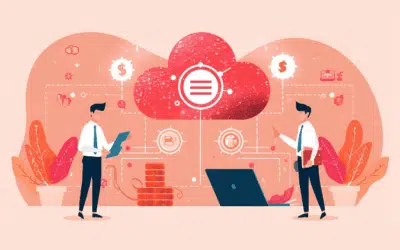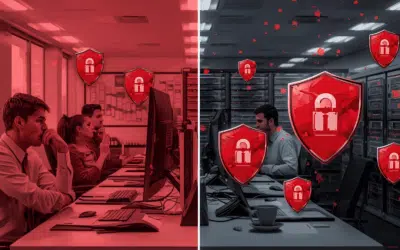Cybercriminals are not chasing headlines…they are chasing easy wins. That makes small and medium-sized businesses (SMBs) a prime target.
Every invoice, payroll record, and client email holds value to an attacker looking for quick access and quick profit. Yet many SMBs still assume they are too small to be noticed. The truth is the opposite: hackers rely on that assumption. With limited staff, aging systems, and growing compliance demands, SMBs face an uphill battle. A single breach can stall operations, damage customer trust, and create costs that are hard to recover from. This post examines why SMBs are at risk and the steps every business can take to push back.
Attackers look for weak controls, outdated systems, or exposed credentials. A breach can interrupt operations, impose costs, and erode trust with clients and partners. If your business handles health, financial, or personal data, compliance obligations make this even more urgent. A clear, risk-based plan helps make protection achievable. This post examines the threats SMBs face and outlines steps to defend what matters most.
Why SMBs Draw Attackers
Attackers seek paths of least resistance. Smaller organizations often unpatched machines, weak security policies, and insecure network devices that hackers can’t wait to exploit.. Understanding why SMBs are attractive helps you place defensive priorities.
Data value in SMB environments
SMBs accumulate customer contacts, financial records, invoice histories, contracts, intellectual property, and internal communications. All these data types carry value to threat actors. A single compromised mailbox might reveal wire instructions, vendor relationships, or passwords to secondary systems. Attackers often aggregate small wins into bigger ones by pivoting through connected accounts or assets.
Supply chain and partner link risks
Many SMBs are part of larger business ecosystems. Vendors, subcontractors, and service providers link to bigger firms. If attackers breach a smaller partner, they may use that entry point to reach higher-value targets. Shared credentials, remote support tools, and data exchange portals strengthen these bridges. Reducing broad access and reviewing third-party connections shrinks that risk.
Remote and hybrid work vulnerabilities
The shift to hybrid work introduces gaps. Personal routers, unmanaged devices, and home networks can serve as gateways. Users may store business data on local machines or sync with personal apps. Without strong identity verification and device health policies, legitimate access can mask malicious entry. Securing endpoints and enforcing least-privilege access become critical in this environment.
Threats SMBs Face Frequently
Certain threats appear repeatedly in SMB breach reports. Recognizing their patterns helps shape defensive strategy. Two stand out.
Phishing and social engineering
Phishing attacks mislead users through email, text, or voice requests. Attackers impersonate familiar vendors, colleagues, or services to trick users into revealing credentials or clicking links that install tools. After gaining entry, adversaries move laterally to find data or functions worth leveraging. Social engineering also includes phone calls asking for codes, payment redirection, or internal requests that mimic leadership.
Security awareness training increases user vigilance. Regular simulated phishing exercises teach how to spot suspicious cues and report potential attacks quickly. That reduces dwell time—the period attackers roam inside systems before detection.
Ransomware plus data theft
Modern ransomware routines steal data first, then encrypt systems and threaten to publish sensitive information if ransom is not paid. This double extortion model raises the stakes and pressures victims to comply. Even if backups exist, reputational damage or regulatory exposure from stolen data often forces negotiation.
A strong backup strategy is insufficient unless backups are isolated and regularly tested. Recovery plans must map applications, dependencies, restoration order, and roles. Teams that rehearse recovery steps shorten downtime and reduce stress under real attack pressure.
Practical Steps SMBs Can Take Immediately
Security improvements do not need to happen all at once. The most effective approach is to prioritize actions that immediately reduce the chances of a successful attack. For SMBs, this often means reinforcing identity, reducing user-driven risks, and adding expert support. Taken together, these measures create a stronger foundation without overwhelming budgets or teams.
Strengthen identity, access, and update practices
Controlling who has access to systems and keeping those systems current are two of the most important defenses. Multifactor authentication (MFA) adds a second layer of protection and is effective at stopping most credential theft attempts. SMBs should begin by applying MFA to email, administrator accounts, and any service that can be accessed remotely. Over time, expand MFA to all users. Conditional access policies in Microsoft 365 allow businesses to require device health checks or restrict access by location, which reduces risks from compromised accounts.
Equally important is patching. Attackers often scan the internet for known vulnerabilities, and unpatched systems are easy entry points. Automating updates reduces human error and keeps systems current. Beyond operating systems, patching must extend to applications, servers, and network devices. When patch management is consistent, many of the most common exploits are no longer effective. SMBs should also test updates in small batches to reduce operational disruptions before company-wide deployment.
Train staff and filter email traffic
Most cyberattacks start with simple (and unintentional) human error. Effective training helps employees recognize phishing emails, suspicious links, and other signs of manipulation. Training works best when it is ongoing and interactive rather than a one-time event. SMBs can schedule short quarterly sessions and use simulated phishing exercises to give employees practice in spotting threats. Reinforcing lessons with reminders in newsletters or team meetings keeps awareness high.
At the same time, applying technology to filter messages removes many threats before employees see them. Microsoft Defender for Office 365 within Microsoft 365 provides advanced filtering that blocks malicious attachments, prevents spoofing, and flags suspicious content. These tools reduce the number of dangerous emails that reach inboxes. Combining employee training with strong filtering creates two layers of defense—one technical and one human—that complement each other.
Use managed or co-managed support
Even when SMB leaders understand what needs to be done, they may not have the time or staff to carry it out consistently. Managed or co-managed IT support provides access to the monitoring, expertise, and automation that keep defenses current. With co-managed IT services, your team remains in control of strategy while Axxys engineers handle monitoring, response, and daily updates. This partnership strengthens defenses without the cost of building a full internal security team.
A managed approach also adds visibility. Regular reports on patch compliance, MFA adoption, backup tests, and phishing results give leaders concrete data. This information supports planning and budget decisions while showing progress to stakeholders. With expert oversight, SMBs can move from reacting to incidents toward building a proactive program that grows with the business.
Closing Thoughts
SMBs cannot afford to assume they are too small to be targeted. Attackers look for the easiest entry point, and unpatched systems, weak credentials, or untrained staff can provide exactly that. The good news is that strong defenses do not require enterprise budgets. By focusing on identity protection, email security, reliable backups, regular patching, and ongoing training, smaller businesses can build resilience against the most common threats. Adding managed or co-managed IT support further strengthens defenses while freeing internal teams to focus on growth.
At Axxys Technologies, we work directly with businesses across North Texas to design and manage cybersecurity programs that fit real-world needs. Our local clients count on us for hands-on expertise, responsive support, and solutions that balance security with productivity. Whether you need guidance on Microsoft 365 security, support for compliance, or a partner to monitor and manage your environment, we are here to help.
If you are ready to reduce risk and protect your business, contact Axxys today to schedule a cybersecurity assessment. Together, we can build a plan that protects your data, your people, and your future.








